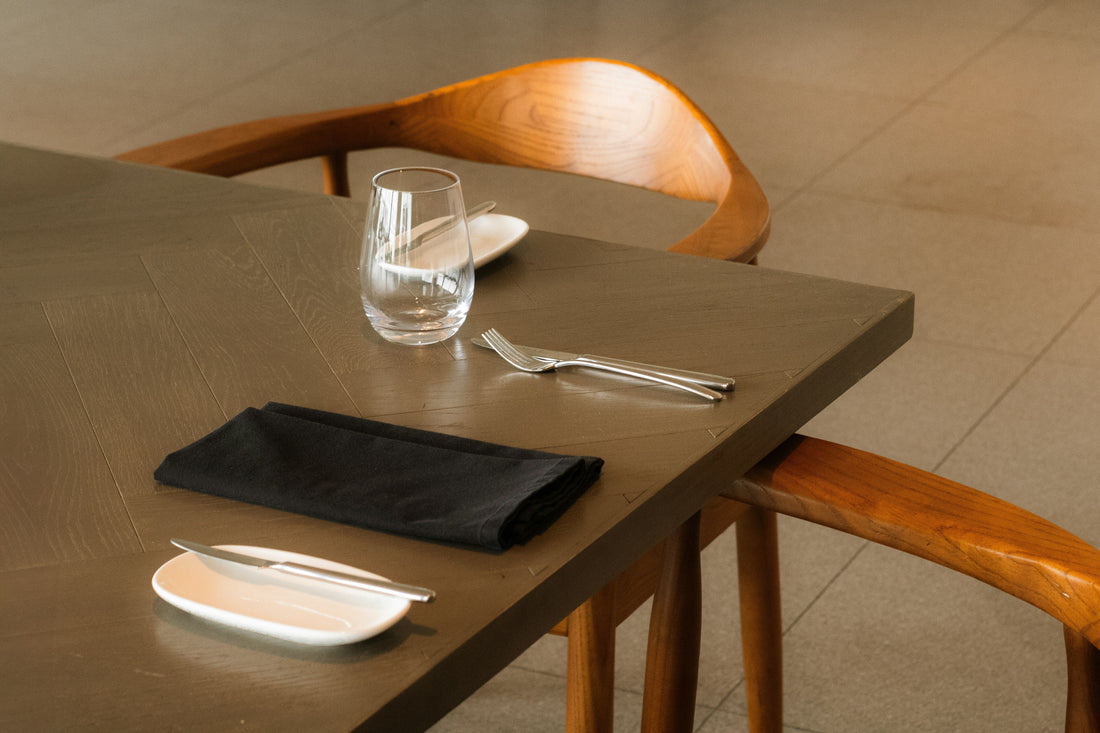
How Do I Maintain and Care for My Dining Table? A Guide
Share
A dining table, often maintained with oil for added shine, grounds the heart of a home. Whether you’re gathered with friends for a lively dinner over ceramic plates or working through emails over breakfast, it’s a reliable centrepiece that blends style, function, and comfort. But everyday life can be hard on even the most robust table, which is why regular polishing and proper dining maintenance can help maintain its luster and resilience. From spilled drinks to hot serving dishes, your dining table faces a parade of challenges. Proper care and thoughtful maintenance ensure it remains beautiful year after year, whether it’s crafted from sleek marble, classic oak or contemporary veneer. Making a few smart choices can prolong the life of your furniture, enhance its durability, preserve its appearance, and create a welcoming backdrop for every meal.
Why regular table care matters
Tables are an investment — both financially and emotionally. They host countless meals, carry the weight of celebrations, and witness countless conversations. In many households, the dining table is the most used piece of furniture, second only to the kitchen bench.
Well-maintained tables retain their shine, strength, and elegance much longer. Routine upkeep, incorporating regular dining maintenance, prevents common damage and can delay the need for costly repairs or replacements. Simple habits become second nature, making care less of a chore and more a natural part of enjoying your home.
Daily habits for table preservation with effective cleaning tips
Preventative care is your best ally. A handful of practical habits can shield your dining table from damage:
● Use placemats and coasters for all meals and drinks.
● Wipe up spills immediately to prevent permanent stains, staining, or warping.
● Avoid placing hot pots, pans, or plates directly onto the table’s surface; use trivets or heat-resistant mats.
● Give your table a gentle wipe with a soft, damp cloth after use.
Paying close attention to these habits helps maintain the table’s original finish, whether you’ve chosen trendy marble or a classic timber surface.
Cleaning according to your table’s material
Different materials require different methods. The wrong product or cloth can leave streaks, scratches, or dull the finish. Below you’ll find a quick guide for the most common dining table surfaces:
| Material | Routine Cleaning | What to Avoid |
| Solid wood | Mild soapy water, soft cloth | Harsh chemicals, excess water |
| Veneer | Soft, dry cloth for dusting | Soaking, abrasive pads |
| Marble | pH-neutral cleaner, soft cloth | Acidic cleaners, vinegar, lemon |
| Glass | Glass cleaner, microfibre cloth | Paper towels, gritty sponges |
| Metal | Damp cloth, dry thoroughly | Bleach, abrasive cleaners |
Extra tip: If your table has a lacquered finish, a mild furniture polish or wax suited to your material can maintain a lustrous sheen, but always check the care instructions provided by your manufacturer first.
Protection from New Zealand’s unique environment
Homes across New Zealand can face a range of climate conditions, from humid Northland summers to crisp Otago winters. Natural materials — especially wood — expand and contract in response to changes in humidity and temperature. This can lead to warping or splitting if unchecked.
Some practical steps for New Zealand homes:
● Avoid placing your furniture, especially the table, directly in the sunlight. UV rays can fade finishes, and accumulated dust can dull the surface, especially on darker wood or veneers.
● Use blinds or curtains to control exposure during the sunniest part of the day.
● If possible, regulate indoor humidity with a dehumidifier or humidifier, keeping it between 40-60%.
● Don’t position your table right over a heater or next to a fireplace.
Routine deep cleaning and dining maintenance seasonal attention
Every few months, your table deserves more than a daily wipe-down and can benefit from specific cleaning tips to maintain its appearance. Deep cleaning and polishing remove build-up and help restore vibrancy. For solid wood, use an oil-based cleaner made for timber furniture, massaging gently with the grain. For marble, follow with a stone sealer every six to twelve months to repel stains.
Marble deserves special mention. While it's undeniably chic, it can be porous. Wines, tomato sauces, and citrus can all leave marks if not wiped promptly. Regular sealing helps marble resist staining. Even so, try to avoid cutting food directly on marble surfaces as knives can leave a permanent trace.
Tables with glass or ceramic tops need a streak-free finish. Microfibre cloths and a quality glass cleaner keep things sparkling. Avoid paper towels or tissue which may scratch the surface.
Repairing minor marks and scratches
Life’s little accidents happen. Scratches, water rings, or stubborn marks don’t have to spell disaster. Here are common fixes for various materials:
● Surface scratches on wood can sometimes be masked with a matching wood marker or specialist repair product.
● For sticky residue or water rings, a gentle dab of mayonnaise left for a few minutes before wiping clean may lift the mark on sealed wood.
● Chips in veneer or glass may need professional repair, but minor issues can sometimes be hidden with colour-matched wax filler.
Always test a small, inconspicuous area before applying any substance to your dining table.
Tips for homes with kids and pets
Busy family life brings its own set of challenges. Sticky fingers, colouring mishaps, or exuberant puppy paws occasionally collide with your dining table. Durable placemats, a clear table runner, or a fitted tablecloth can add a protective layer without masking the table’s beauty and enhancing its durability.
Here are a few extra strategies:
● Encourage older children to use coasters and wipe up after themselves.
● Opt for round tables or those with rounded corners if you have toddlers — these help avoid bumps and scrapes.
● Clean up sticky spills as soon as possible to avoid residue hardening.
Arranging your space for the table’s longevity involves careful dining maintenance
How you position your table and what furniture surrounds it also affects its lifespan. Choosing the right dining chairs, for example, prevents accidental scratches and scuffs.
● Leave enough space between chair backs and walls (at least 90cm) to minimise bumps.
● Use felt pads on chair legs to stop scrapes on wood or tile floors.
● Rotate the table occasionally so wear is distributed evenly, especially if sunlight only hits one end.
Choosing the right products for everyday dining maintenance
The market is filled with cleaning, dust, and protection products for furniture. Select those that suit your table’s surface and avoid multi-purpose sprays unless specifically recommended. For marble, stick to stone-safe options; for wood, look for gentle, pH-neutral cleaners and consider using oil treatments to enhance the finish, and for ceramic surfaces, choose products that prevent cracking and maintain sheen. A little investment here maintains both appearance and hygiene.
Here are essentials for most households:
● Soft microfibre cloths
● pH-neutral detergent
● High-quality polish or wax (for timber)
● Stone sealer (for marble)
● Coasters and placemats
Don’t overlook the instruction labels or care manuals that came with your table. Manufacturers know their products best.
Revitalising your table’s look without damaging your furniture can enhance its durability
Sometimes, a styling update doubles as protection against staining. Table runners, centrepieces, and decorative trays add personality while creating a barrier between the tabletop and daily wear.
Some easy ways to refresh and protect:
● Use a textile runner or a woven tray to catch accidental spills.
● Place flowers in vases with felt bottoms to avoid scratches.
● Rotate centrepieces or table decorations to even out sun exposure and prevent fading.
Quick reference: Table maintenance by material
Here’s a handy snapshot for busy homeowners on keeping popular table styles in great condition:
| Table Type | Daily Care Tip | Long-Term Care Suggestion |
| Natural wood | Wipe spills immediately | Polish with wax every 3-6 months |
| Marble | Use coasters, wipe stains | Apply new sealant every 6-12 months |
| Veneer | Dust with soft cloth | Avoid sharp objects and don’t over-wet |
| Glass | Clean with microfibre | Avoid stacking heavy objects |
| Metal | Dry thoroughly after cleaning | Use rust-inhibiting spray if needed |
Investing effort into dining table, furniture care, and dining maintenance isn’t about rules and restrictions, but involves incorporating effective cleaning tips for longevity. It’s a few mindful steps that help keep this centrepiece reflective of your style and ready for memories for years to come. Matching practical habits with a love for interiors means your table will always be ready for whatever comes next.


